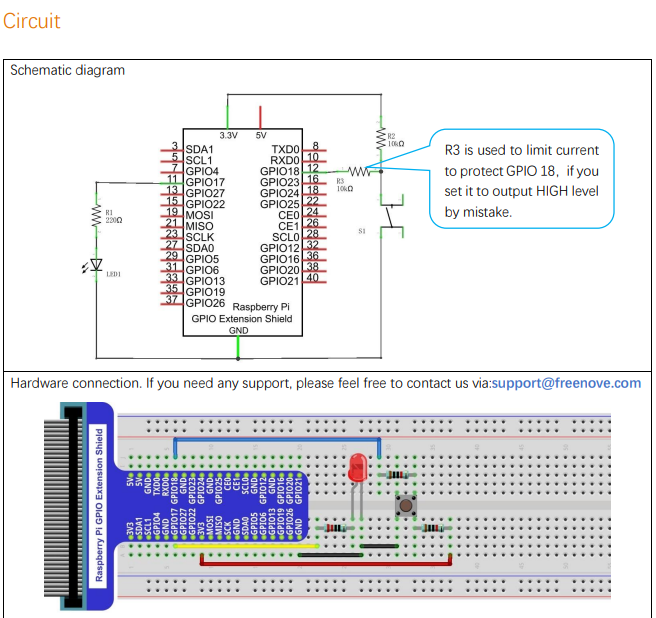Tablelamp using Buttons & LED
In this article, we're going to use a push button and an LED to build a tablelamp that turns on when pushed and turns off when pushed again.
Circuit

Code
C
#include <wiringPi.h>
#include <stdio.h>
#define ledPin 0 //define the ledPin
#define buttonPin 1 //define the buttonPin
int ledState=LOW; //store the State of led
int buttonState=HIGH; //store the State of button
int lastbuttonState=HIGH;//store the lastState of button
long lastChangeTime; //store the change time of button state
long captureTime=50; //set the stable time for button state
int reading;
int main(void)
{
printf("Program is starting...\n");
wiringPiSetup(); //Initialize wiringPi.
pinMode(ledPin, OUTPUT); //Set ledPin to output
pinMode(buttonPin, INPUT); //Set buttonPin to input
pullUpDnControl(buttonPin, PUD_UP); //pull up to high level
while(1){
reading = digitalRead(buttonPin); //read the current state of button
if( reading != lastbuttonState){ //if the button state has changed, record the time point
lastChangeTime = millis();
}
//if changing-state of the button last beyond the time we set, we consider that
//the current button state is an effective change rather than a buffeting
if(millis() - lastChangeTime > captureTime){
//if button state is changed, update the data.
if(reading != buttonState){
buttonState = reading;
//if the state is low, it means the action is pressing
if(buttonState == LOW){
printf("Button is pressed!\n");
ledState = !ledState; //Reverse the LED state
if(ledState){
printf("turn on LED ...\n");
}
else {
printf("turn off LED ...\n");
}
}
//if the state is high, it means the action is releasing
else {
printf("Button is released!\n");
}
}
}
digitalWrite(ledPin,ledState);
lastbuttonState = reading;
}
return 0;
}
Python
Tablelamp.py
import RPi.GPIO as GPIO
ledPin = 11 # define ledPin
buttonPin = 12 # define buttonPin
ledState = False
def setup():
GPIO.setmode(GPIO.BOARD) # use PHYSICAL GPIO Numbering
GPIO.setup(ledPin, GPIO.OUT) # set ledPin to OUTPUT mode
GPIO.setup(buttonPin, GPIO.IN, pull_up_down=GPIO.PUD_UP) # set buttonPin to PULL UP INPUT mode
def buttonEvent(channel): # When button is pressed, this function will be executed
global ledState
print ('buttonEvent GPIO%d' %channel)
ledState = not ledState
if ledState :
print ('Led turned on >>>')
else :
print ('Led turned off <<<')
GPIO.output(ledPin,ledState)
def loop():
#Button detect
GPIO.add_event_detect(buttonPin,GPIO.FALLING,callback = buttonEvent,bouncetime=300)
while True:
pass
def destroy():
GPIO.cleanup() # Release GPIO resource
if __name__ == '__main__': # Program entrance
print ('Program is starting...')
setup()
try:
loop()
except KeyboardInterrupt: # Press ctrl-c to end the program.
destroy()